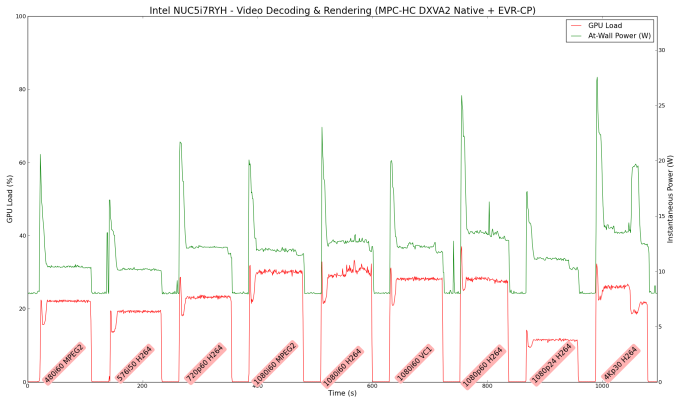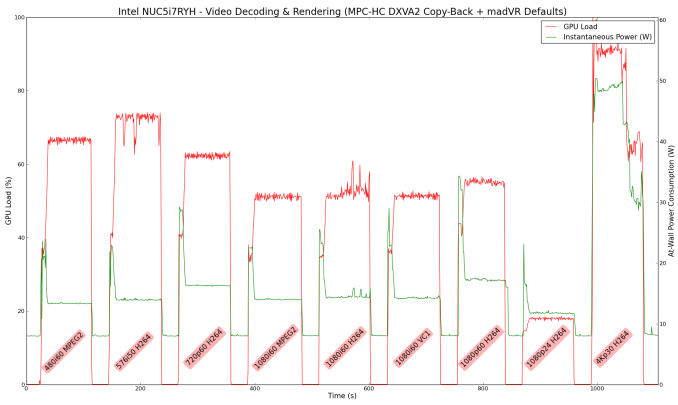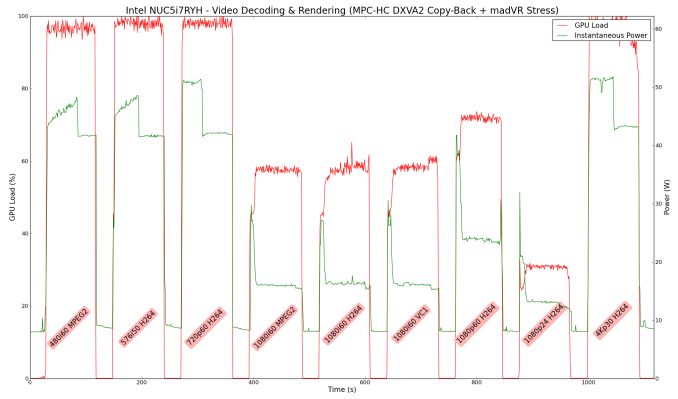Intel NUC5i7RYH Broadwell-U Iris NUC Review
by Ganesh T S on April 20, 2015 8:00 AM EST- Posted in
- Systems
- Intel
- HTPC
- NUC
- Broadwell-U
HTPC Credentials
The NUC5i7RYH is a UCFF PC, but, thanks to the 28W TDP CPU inside, the thermal solution required is a bit more noisy compared to what we saw in the NUC5i5RYK. Subjectively speaking, the unit is silent for most common HTPC use-cases. Only under heavy CPU / GPU loading (such as stressful madVR configurations) does the fan become audible. In our investigation, recent software improvements in the software chain for playback on Windows have lightened the stress considerably. The NUC5i7RYH definitely makes a good HTPC for folks who don't want to pay the premium for a passively cooled system - however, we didn't find too many improvements over the NUC5i5RYK for HTPC workloads. The Iris NUC also has CIR support enabling use of IR remotes in a home theater setting.
Refresh Rate Accurancy
Starting with Haswell, Intel, AMD and NVIDIA have been on par with respect to display refresh rate accuracy. The most important refresh rate for videophiles is obviously 23.976 Hz (the 23 Hz setting). As expected, the Intel NUC5i7RYH has no trouble with refreshing the display appropriately in this setting.
The gallery below presents some of the other refresh rates that we tested out. The first statistic in madVR's OSD indicates the display refresh rate.
Network Streaming Efficiency
Evaluation of OTT playback efficiency was done by playing back our standard YouTube test stream and five minutes from our standard Netflix test title. Using HTML5, the YouTube stream plays back a 720p encoding. Since YouTube now defaults to HTML5 for video playback, we have stopped evaluating Adobe Flash acceleration. Note that only NVIDIA exposes GPU and VPU loads separately. Both Intel and AMD bundle the decoder load along with the GPU load. The following two graphs show the power consumption at the wall for playback of the HTML5 stream in Mozilla Firefox (v 37.0.1).

GPU load was around 12.58% for the YouTube HTML5 stream and 2.41% for the steady state 6 Mbps Netflix streaming case.
Netflix streaming evaluation was done using the Windows 8.1 Netflix app. Manual stream selection is available (Ctrl-Alt-Shift-S) and debug information / statistics can also be viewed (Ctrl-Alt-Shift-D). Statistics collected for the YouTube streaming experiment were also collected here.

Surprisingly, the Iris NUC emerges as the most power-efficient configuration for OTT streaming amongst the configurations compared above. The mainstream NUC5i5RYK build (using slower DRAM and a M.2 SATA SSD) is more power efficient for OTT streaming, but those numbers are not presented in the graphs above. Thie observed numbers could be due to a number of factors - software and driver updates as well as more power efficient components inside the build.
Decoding and Rendering Benchmarks
In order to evaluate local file playback, we concentrate on EVR-CP and madVR using the mainstream configuration (which has the 1600 MHz DRAM). We already know that EVR works quite well even with the Intel IGP for our test streams. In our Broadwell BRIX s review, we found the HD Graphics 5500 to be incapable of downscaling 4kp30 to 1080p using default madVR settings. Could Iris / Iris Graphics 6100 help in this aspect? Have software updates to LAV Filters (0.64.0) and madVR (0.87.1) delivered increased playback efficiency? Our experimental results presented below provide the answers.
In our earlier reviews, we focused on presenting the GPU loading and power consumption at the wall in a table (with problematic streams in bold). Starting with the Broadwell NUC review, we decided to represent the GPU load and power consumption in a graph with dual Y-axes. Nine different test streams of 90 seconds each were played back with a gap of 30 seconds between each of them. The characteristics of each stream are annotated at the bottom of the graph. Note that the GPU usage is graphed in red and needs to be considered against the left axis, while the at-wall power consumption is graphed in green and needs to be considered against the right axis.
Frame drops are evident whenever the GPU load consistently stays above the 85 - 90% mark. In addition to tracking that aspect in the graphs below, we also get an idea of the system's power efficiency for decode and playback of some common codecs.
EVR-CP doesn't present any challenges to the Iris Graphics 6100
Iris Graphics 6100 still struggles with 4Kp30 downscaling to 1080p with madVR's default settings
In addition to the above configurations, we also set up a 'madVR stress configuration' with the upscaling algorithms set to Jinc 3-tap with anti-ringing activated and the downscaling algorithm set to Lanczos 3-tap, again with anti-ringing activated.
Iris Graphics 6100 is unable to handle luma scaling with our madVR stress settings
We find that all streams that involve luma scaling for display on a 1080p screen (interlaced standard definition and progressive high definition as well as ultra high definition) consistently loaded up the GPU above 95% and plenty of dropped frames during playback.
The Iris Graphics 6100 is a definite step-up over the HD Graphics 6000. However, the improvements for HTPC workloads are marginal at best. The NUC5i7RYH Iris NUC can only be recommended if a UCFF PC is desired for light gaming in addition to HTPC workloads.



















66 Comments
View All Comments
ShieTar - Monday, April 20, 2015 - link
Depends on what you mean with "the M.2 spec". I have a XP941 on a MSI Z97 Board, its measurably faster than the 840Pro I came from.I figure in this case the problem should be with the NUC board rather than the interface spec. The Plextor itself is not fast enough to profit from the interface, but it should be fast enough to work without noticable stuttering.
nutternatter34 - Tuesday, April 21, 2015 - link
In my case we're talking about an X99 board, and an Intel 530 series M.2 drive (180gb). I compared that to each SSD I own. An Intel 320 series, a Samsung 830 series and the Crucial MX100 series. (120gb/256gb/512gb). M.2 was a disaster, what's worse there's barely anything to configure, it should just work.meacupla - Monday, April 20, 2015 - link
Oh, so this is limited to 45W?I wonder what the 3rd party makers could do with this chip if they expanded the power envelope and cooling capabilities.
Qwertilot - Monday, April 20, 2015 - link
28w for the CPU/GPU, 17 for the rest even ;)I guess we'll find out what is possible when Broadwell K finally makes its much delayed appearance....
charea - Monday, April 20, 2015 - link
So why use a 65W brick for a system limited at 45W? It doesn't make sense.close - Monday, April 20, 2015 - link
If you're going to power some more devices from the system then it helps to have a power source that's slightly oversized.charea - Monday, April 20, 2015 - link
Are you saying that the monitor is excluded from this limit? Was the test done without a screen included?dave_the_nerd - Monday, April 20, 2015 - link
USB devices pull up to 5w each. The test doesn't include a monitor. 30-40w draw for a 24" monitor is typical.ganeshts - Monday, April 20, 2015 - link
Right - 4x USB 3.0 ports need 20W. Add that to the 45W, and you are already at the 65W limit.Our stress test only loads up the CPU and GPU - it doesn't even do the internal storage stressing or WLAN stressing - these are bound to increase the power consumption a bit. That said, stressing those might actually result in the CPU not getting loaded as much as it does in our Prime 95 test.
ShieTar - Monday, April 20, 2015 - link
And thats nicely keeping to the spec, there are ports and charger cables out there working with 2A => 10W.